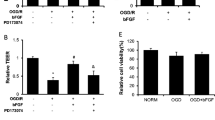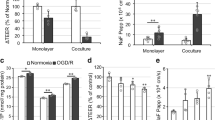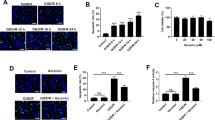Abstract
Fructose-1,6-bisphosphate (FBP), a glycolytic intermediate, has neuroprotective effects in various brain injury models. However, its effects on blood–brain barrier (BBB) are largely unknown. In this study, we investigated the effects of FBP on lipopolysaccharide (LPS)-induced BBB dysfunction in in vitro BBB model comprising co-culture of mouse brain endothelial cell line, bEnd.3 and mouse primary astrocyte and explored its action mechanism therein involved. LPS induced the impairment of endothelial permeability and transendothelial electrical resistance (TEER). The functional changes were confirmed by alterations in immunostaining for junctional proteins occludin, ZO-1 and VE-cadherin, such as the loss of cortical staining pattern and appearance of intercellular gaps in endothelial cells. Co-administration of FBP alleviated the deleterious effects of LPS on BBB permeability and TEER in a dose dependent manner. And also FBP inhibited the LPS-induced changes in the distribution of endothelial junctional proteins, resulting in the better preservation of monolayer integrity. FBP suppressed the production of reactive oxygen species (ROS) but did not affect cyclooxygenase-2 expression and prostaglandin E2 production in endothelial cells stimulated with LPS. Taken together, these data suggest that FBP could ameliorate LPS-induced BBB dysfunction through the maintenance of junctional integrity, which might be mediated by downregulation of ROS production.







Similar content being viewed by others
References
Abbott, N.J. 2000. Inflammatory mediators and modulation of blood–brain barrier permeability. Cellular and Molecular Neurobiology 20: 131–147.
Ahn, S.M., J.S. Hwang, and S.H. Lee. 2007. Fructose 1,6-diphosphate alleviates UV-induced oxidative skin damage in hairless mice. Biological and Pharmaceutical Bulletin 30: 692–697.
Ahn, S.M., H.Y. Yoon, B.G. Lee, K.C. Park, J.H. Chung, C.H. Moon, and S.H. Lee. 2002. Fructose-1,6-diphosphate attenuates prostaglandin E2 production and cyclooxygenase-2 expression in UVB-irradiated HaCaT keratinocytes. British Journal of Pharmacology 137: 497–503.
Alves-Filho, J.C., R.C. Santos, T.A. Castaman, and J.R. de Oliveira. 2004. Anti-inflammatory effects of fructose-1,6-bisphosphate on carrageenan-induced pleurisy in rat. Pharmacological Research 49: 245–248.
Arismendi-Morillo, G., and A. Castellano. 2005. Tumoral micro-blood vessels and vascular microenvironment in human astrocytic tumors. A transmission electron microscopy study. Journal of Neuro-Oncology 73: 211–217.
Banks, W.A., and M.A. Erickson. 2010. The blood–brain barrier and immune function and dysfunction. Neurobiology of Diseases 37: 26–32.
Bannerman, D.D., and S.E. Goldblum. 1999. Direct effects of endotoxin on the endothelium: Barrier function and injury. Laboratory Investigation 79(10): 1181–1199.
Bickler, P.E., and L.T. Buck. 1996. Effects of fructose-1,6-bisphosphate on glutamate release and ATP loss from rat brain slices during hypoxia. Journal of Neurochemistry 67(4): 1463–1468.
Brown, R.C., A.P. Morris, and R.G. O’Neil. 2007. Tight junction protein expression and barrier properties of immortalized mouse brain microvessel endothelial cells. Brain Research 1130: 17–30.
Cardenas, A., O. Hurtado, J.C. Leza, P. Lorenzo, R. Bartrons, I. Lizasoain, and M.A. Moro. 2000. Fructose-1,6-bisphosphate inhibits the expression of inducible nitric oxide synthase caused by oxygen-glucose deprivation through the inhibition of glutamate release in rat forebrain slices. Naunyn Schmiedebergs Archives of Pharmacology 362: 208–212.
Cardoso, F.L., D. Brites, and M.A. Brito. 2010. Looking at the blood–brain barrier: Molecular anatomy and possible investigation approaches. Brain Research 64: 328–363.
Cardoso, F.L., A. Kittel, S. Veszelka, I. Palmela, A. Toth, D. Brites, M.A. Deli, and M.A. Brito. 2012. Exposure to lipopolysaccharide and/or unconjugated bilirubin impair the integrity and function of brain microvascular endothelial cells. PLoS One 7: e35919.
Cohly, H., J. Jenkins, T. Skelton, E. Meydrech, and A.K. Markov. 2004. Fructose-1,6-diphosphate suppresses T-lymphocyte proliferation, promotes apoptosis and inhibits interleukins-1, 6, beta-actin mRNAs, and transcription factors expression. Immunological Investigations 33: 407–421.
de Boer, A.G., and P.J. Gaillard. 2006. Blood–brain barrier dysfunction and recovery. Journal of Neural Transmission 113: 455–462.
Deli, M.A., C.S. Abraham, Y. Kataoka, and M. Niwa. 2005. Permeability studies on in vitro blood–brain barrier models: Physiology, pathology, and pharmacology. Cellular and Molecular Neurobiology 25(1): 59–127.
Dohgu, S., and W.A. Banks. 2008. Lipopolysaccharide-enhanced transcellular transport of HIV-1 across the blood–brain barrier is mediated by the p38 mitogen activated protein kinase pathway. Experimental Neurology 210: 740–749.
Edde, L., X. Zhou, J.W. Eaton, and M.P. Sherman. 1998. Induction of nitric oxide synthase in macrophages: Inhibition by fructose-1,6-diphosphate. Biochemical and Biophysical Research Communications 243(3): 683–687.
Espanol, M.T., L. Litt, K. Hasegawa, L.H. Chang, J.M. Macdonald, G.A. Gregory, T.L. James, and P.H. Chan. 1998. Fructose-1,6-bisphosphate preserves adenosine triphosphate but not intracellular pH during hypoxia in respiring neonatal rat brain slices. Anesthesiology 88(2): 461–472.
Fahlman, C.S., P.E. Bickler, B. Sullivan, and G.A. Gregory. 2002. Activation of the neuroprotective ERK signaling pathway by fructose-1,6-bisphosphate during hypoxia involves intracellular Ca2+ and phospholipase C. Brain Research 958: 43–51.
Farias, L.A., E.E. Smith, and A.K. Markov. 1990. Prevention of ischemic-hypoxic brain injury and death in rabbits with fructose-1,6-diphosphate. Stroke 21: 606–613.
Fischer, S., M. Wiesnet, D. Renz, and W. Schaper. 2005. H2O2 induces paracellular permeability of porcine brain-derived microvascular endothelial cells by activation of the p44/42 MAP kinase pathway. European Journal of Cell Biology 84(7): 687–697.
Gaillard, P.J., L.H. Voorwinden, J.L. Nielsen, A. Ivanov, R. Atsumi, H. Egman, C. Ringbom, A.G. de Boer, and D.D. Breimer. 2001. Establishment and functional characterization of an in vitro model of the blood–brain barrier, comprising a co-culture of brain capillary endothelial cells and astrocytes. European Journal of Pharmaceutical Sciences 12: 215–222.
Gobbel, G.T., T.Y. Chan, G.A. Gregory, and P.H. Chan. 1994. Response of cerebral endothelial cells to hypoxia: Modification by fructose-1,6-bisphosphate but not glutamate receptor antagonists. Brain Research 653(1–2): 23–30.
Hardin, C.D., and T.M. Roberts. 1994. Metabolism of exogenously applied fructose 1,6-bisphosphate in hypoxic vascular smooth muscle. American Journal of Physiology 267: H2325–H2332.
He, F., J. Peng, X.L. Deng, L.F. Yang, L.W. Wu, C.L. Zhang, and F. Yin. 2011. RhoA and NF-kB are involved in lipopolysaccharide-induced brain microvascular cell line hyperpermeability. Neuroscience 188: 35–47.
Hofer, R.E., S.R. Wagner, J.J. Pasternak, R.F. Albrecht, W.J. Gallagher, and W.L. Lanier. 2009. Fructose-1,6-bisphosphate and fructose-2,6-bisphosphate do not influence brain carbohydrate or high-energy phosphate metabolism in a rat model of forebrain ischemia. Journal of Neurosurgical Anesthesiology 21: 31–39.
Huwyler, J., J. Drewe, C. Klusemann, and G. Fricker. 1996. Evidence for P-glycoprotein-modulated penetration of morphine-6-glucuronide into brain capillary endothelium. British Journal of Pharmacology 118: 1879–1885.
Kaakinen, T., J. Heikkinen, S. Dahlbacka, H. Alaoja, P. Laurila, K. Kiviluoma, T. Salomäki, P. Romsi, H. Tuominen, F. Biancari, P. Lepola, M. Nuutinen, and T. Juvonen. 2006. Fructose-1,6-bisphosphate supports cerebral energy metabolism in pigs after ischemic brain injury caused by experimental particle embolization. Heart Surgery Forum 9: E828–E835.
Kim, Y.A., S.L. Park, M.Y. Kim, S.H. Lee, E.J. Baik, C.H. Moon, and Y.S. Jung. 2010. Role of PKCβII and PKCδ in blood–brain barrier permeability during aglycemic hypoxia. Neuroscience Letters 468(3): 254–258.
Kim, Y.C., T.Y. Park, E.J. Baik, and S.H. Lee. 2012. Fructose-1,6-bisphosphate attenuates induction of nitric oxide synthase in microglia stimulated with lipopolysaccharide. Life Sciences 90: 365–372.
Kuluz, J.W., G.A. Gregory, Y. Han, W.D. Dietrich, and C.L. Schleien. 1993. Fructose-1,6-bisphosphate reduces infarct volume after reversible middle cerebral artery occlusion in rats. Stroke 24: 1576–1583.
Kusch-Poddar, M., J. Drewe, I. Fux, and H. Gutmann. 2005. Evaluation of the immortalized human brain capillary endothelial cell line BB19 as a human cell culture model for the blood–brain barrier. Brain Research 1064(1–2): 21–31.
Lagrange, P., I.A. Romero, A. Minn, and P.A. Revest. 1999. Transendothelial permeability changes induced by free radicals in an in vitro model of the blood–brain barrier. Free Radical Biology and Medicine 27(5–6): 667–672.
Liu, J., K. Hirai, and L. Litt. 2008. Fructose-1,6-bisphosphate does not preserve ATP in hypoxic-ischemic neonatal cerebrocortical slices. Brain Research 1238: 230–238.
Omidi, Y., L. Campbell, J. Barar, D. Connell, S. Akhtar, and M. Gumbleton. 2003. Evaluation of the immortalised mouse brain capillary endothelial cell line, b.End3, as an in vitro blood–brain barrier model for drug uptake and transport studies. Brain Research 990(1–2): 95–112.
Pan, W., H. Hsuchou, C. Yu, and A.J. Kastin. 2008. Permeation of blood-borne IL15 across the blood–brain barrier and the effect of LPS. Journal of Neurochemistry 106(1): 313–319.
Park, J.Y., E.J. Kim, K.J. Kwon, Y.S. Jung, C.H. Moon, S.H. Lee, and E.J. Baik. 2004. Neuroprotection by fructose-1,6-bisphosphate involves ROS alterations via p38 MAPK/ERK. Brain Research 1026(2): 295–301.
Pawate, S., Q. Shen, F. Fan, and N.R. Bhat. 2004. Redox regulation of glial inflammatory response to lipopolysaccharide and interferongamma. Journal of Neuroscience Research 77: 540–551.
Pu, H., K. Hayashi, I.E. Andras, S. Eum, B. Hennig, and M. Toborek. 2007. Limited role of COX-2 in HIV Tat-induced alterations of tight junction protein expression and disruption of the blood–brain barrier. Brain Research 1184: 333–344.
Sandoval, K.E., and K.A. Witt. 2008. Blood–brain barrier tight junction permeability and ischemic stroke. Neurobiology of Diseases 32(2): 200–219.
Singh, A.K., Y. Jiang, and S. Gupta. 2007. Effects of bacterial toxins on endothelial tight junction in vitro: A mechanism-based investigation. Toxicology Mechanisms and Methods 17: 331–347.
Song, L., and J.S. Pachter. 2003. Culture of murine brain microvascular endothelial cells that maintain expression and cytoskeletal association of tight junction-associated proteins. In Vitro Cellular and Developmental Biology Animal 39(7): 313–320.
Song, X., B. Wu, T. Takata, X. Wang, X.-S. Oizumi, T. Akisaki, K. Yokono, and T. Sakurai. 2005. Neuroprotective effect of d-fructose-1,6-bisphosphate against β-amyloid induced neurotoxicity in rat hippocampal organotypic slice culture: Involvement of PLC and MEK/ERK signaling pathways. Kobe Journal of Medical Sciences 51(5): 73–83.
Stevenson, B.R., J.M. Anderson, I.D. Braun, and M.S. Mooseker. 1989. Phosphorylation of the tight junction protein ZO-1 in two strains of Madin-Darby canine kidney cells which differ in transepithelial resistance. Biochemical 263: 597–599.
Stringer, J.L., and K. Xu. 2008. Possible mechanisms for the anticonvulsant activity of fructose-1,6-diphosphate. Epilepsia 49: 101–103.
Sumi, N., T. Nishioku, F. Takata, J. Matsmoto, T. Watanabe, H. Shuto, A. Yamauchi, S. Dohgu, and Y. Kataoka. 2010. Lipopolysaccharide-activated microglial induce dysfunction of the blood–brain barrier in rat microvascular endothelial cells co-cultured with microglia. Cellular and Molecular Neurobiology 30: 247–253.
Tang, X.Y., Q. Zhang, D.Z. Dai, H.J. Ying, Q.J. Wang, and Y. Dai. 2008. Effects of strontium fructose 1,6-diphosphate on expression of apoptosis-related genes and oxidative stress in testes of diabetic rats. International Journal of Urology 15: 251–256.
Trimarchi, G.R., F.A. Arcadi, C. Imperatore, P. Ruggeri, and G. Costa. 1997. Effects of fructose-1,6-bisphosphate on microsphere-induced cerebral ischemia in the rat. Life Sciences 61(6): 611–622.
Veszelka, S., M. Pasztoi, A.E. Farkas, I. Krizbai, T.K. Ngo, M. Niwa, C.S. Abrahám, and M.A. Deli. 2007. Pentosan polysulfate protects brain endothelial cells against bacterial lipopolysaccharide-induced damages. Neurochemistry International 50: 219–228.
Vexler, Z.S., A. Wong, C. Francisco, C. Manabat, S. Chriten, and M. Tauber. 2003. Fructose-1,6-bisphosphate preserves intracellular glutathione and protects cortical neurons against oxidative stress. Brain Research 960: 90–98.
Xu, K., and J.L. Stringer. 2008. Pharmacokinetics of fructose-1,6-diphosphate after intraperitoneal and oral administration to adult rats. Pharmacological Research 57: 234–238.
Acknowledgments
This work was supported by the GRRC Program of Gyunggi-Do, Republic of Korea through the Center for Cell Death Regulating Biodrug, Ajou University, Republic of Korea.
Author information
Authors and Affiliations
Corresponding author
Rights and permissions
About this article
Cite this article
Seok, S.M., Kim, J.M., Park, T.Y. et al. Fructose-1,6-bisphosphate ameliorates lipopolysaccharide-induced dysfunction of blood–brain barrier. Arch. Pharm. Res. 36, 1149–1159 (2013). https://doi.org/10.1007/s12272-013-0129-z
Received:
Accepted:
Published:
Issue Date:
DOI: https://doi.org/10.1007/s12272-013-0129-z




